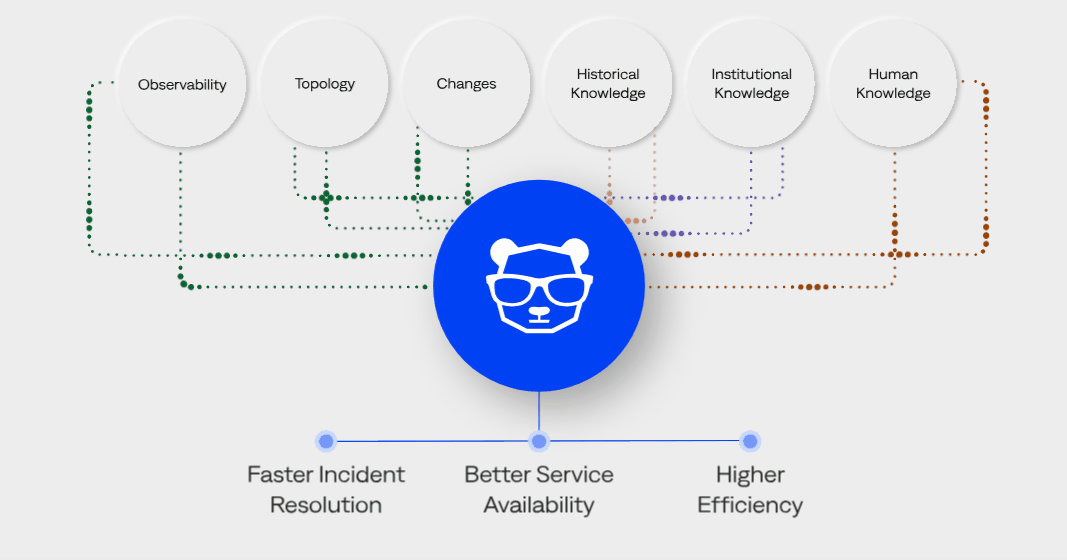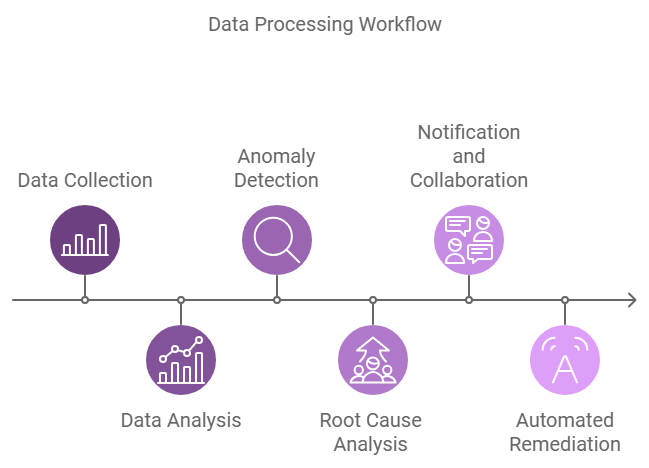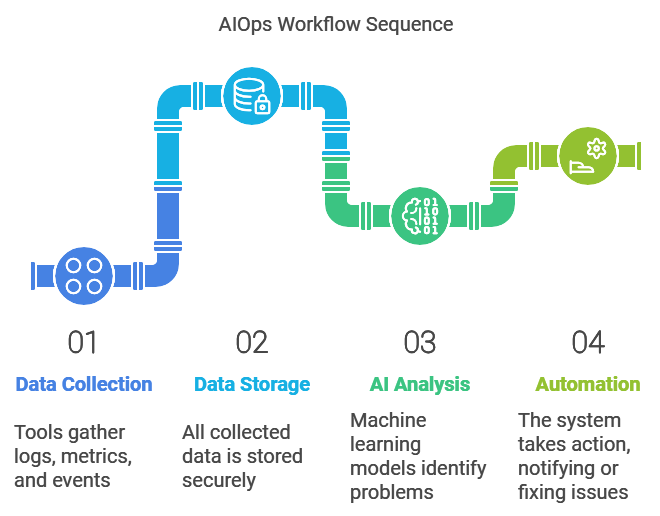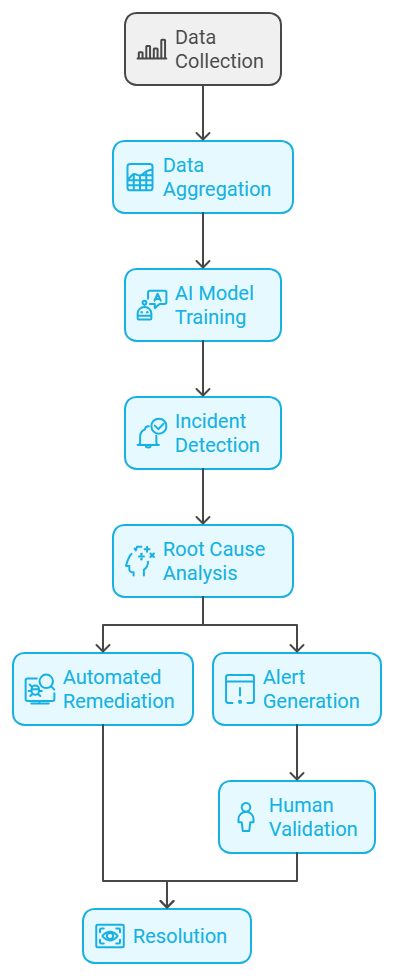AIOps Explained: Steps for Implementation, Real-World Uses, and Career Pathway
 Tanvir Sayyad
Tanvir SayyadTable of contents

This guide to AIOps shows exactly what AIOps is, why it's important, how to use it in daily operations, and how anyone can become an AIOps expert. This simple, step-by-step approach will help you understand why AIOps matters and how it can make IT operations run smoother than ever.
Why AIOps? Understanding the Problem
Before diving into what AIOps entails, it is essential to understand why AIOps has emerged as a crucial tool in IT operations. Imagine an IT operations team at a huge company. They manage dozens of Kubernetes clusters—maybe 25 or even more—with thousands of microservices running on them. These clusters and microservices are constantly sending out data: metrics, logs, traces, and events. If every cluster sends metrics every minute and each microservice generates logs, this adds up to millions of data points daily.
Think about the complexity. Consider a scenario where a single log message among millions indicates a critical warning, such as a deprecation notice that could evolve into a major issue within the next month—spotting this manually would be nearly impossible. Spotting an important issue among millions of data points is like finding a needle in a haystack. It’s unrealistic for a team to manually scan all of these data points. That's where AIOps comes in.
AIOps uses artificial intelligence to help manage and make sense of all this data. The main goal is to automate IT operations by using AI and machine learning to find and fix problems quickly.
What is AIOps?
AIOps stands for Artificial Intelligence for IT Operations. It combines AI and machine learning to streamline IT tasks. Tools like Datadog, New Relic, and Dynatrace help collect, store, and analyze large sets of data from IT systems. The key goal of AIOps is to identify unusual patterns or issues and solve them before they become bigger problems.
In simple terms, AIOps is like a super-smart assistant. It helps analyze all the incoming data, predicts where problems might happen, and prevents them before they start. AIOps focuses on three main things: Analyze, Anticipate, and Avoid.
Key Use Cases of AIOps
AIOps can make IT operations faster, safer, and more effective. Here are some real-world examples:
Spotting Issues Before They Happen
A Kubernetes cluster may use outdated software, like an old logging library that has known security risks. This risk could be missed because of the overwhelming amount of data. AIOps can detect this early and alert the team so they can fix it before it becomes a security issue.
Automated Remediation and Incident Management
AIOps uses ML algorithms to automatically identify root causes and remediate issues. Automated actions such as resource scaling, restarting applications, or executing pre-configured scripts can be triggered based on incident severity, leading to reduced downtime and improved reliability.
Finding the Root Cause Quickly
If something goes wrong in a CI/CD pipeline, like Jenkins builds failing, it often takes a lot of time to find out why. AIOps can analyze the Jenkins logs, find the root cause faster, and even fix minor issues automatically. This helps save time and avoid errors.
Smart Alerts
AIOps filters out unnecessary alerts and only escalates incidents that require action, reducing alert fatigue. ML algorithms help determine which alerts are critical and provide meaningful insights to the appropriate teams.
Cross-Team Collaboration
AIOps enables efficient workflow management by automatically assigning incidents to relevant teams and providing real-time data access to all stakeholders. This helps improve efficiency, especially in distributed environments.
Capacity Management
Using predictive analytics, AIOps can understand system behaviors and forecast resource needs. It helps predict potential storage issues or performance bottlenecks, allowing proactive allocation of resources.
How AIOps Works
There are three main stages to how AIOps operates:
Data Collection
AIOps tools rely heavily on data from observability platforms. AIOps gathers data from various tools, like metrics, logs, and traces. This data is collected and stored in a database for further analysis. Platforms such as Datadog, New Relic, and Dynatrace feed AIOps with all this data for further analysis.
Data Analysis
Once collected, the data is analyzed using AI and machine learning algorithms to identify anything unusual. For example, AIOps can detect when something deviates from the usual pattern, flagging a potential problem.
Root Cause Analysis
After detecting an anomaly, AIOps conducts root cause analysis to pinpoint the source of the problem. This ensures that underlying issues are addressed rather than superficial symptoms, enhancing overall reliability.
Collaboration
The platform notifies the appropriate team members with relevant details for effective collaboration. This helps in quicker resolution and ensures that the right people have the right information.
Automated Remediation
In many cases, AIOps can execute predefined remediation measures automatically. For example, it might trigger a script to restart an application that has experienced a memory leak or, in some advanced cases, automatically applying a fix to resolve the problem.

Real-Life Applications of AIOps
AIOps can revolutionize IT operations across various industries by improving efficiency, agility, and resilience. Here are some notable use cases:
Hybrid Cloud Management
Managing hybrid cloud environments is challenging due to their complexity. AIOps can monitor performance, aggregate logs, and identify bottlenecks across both on-premises and cloud infrastructures.
Automating IT Processes
Large companies can use AIOps to automate repetitive tasks like user provisioning and configuration management. By automating ticket generation, routing, and resolution, AIOps significantly improves efficiency.
Security Threat Detection
AIOps is effective at identifying anomalies such as unauthorized access or unusual downloads, which could indicate a security breach. By correlating such data, AIOps helps IT security teams act in real time.
Customer Experience Enhancement
AIOps analyzes user interaction data to understand and improve the customer experience. It can detect performance issues that impact end users and initiate remediation before these issues cause disruptions.
Capacity Planning
By analyzing historical data, AIOps can help forecast infrastructure needs, ensuring resources are allocated efficiently during high-demand periods.
How to Become an AIOps Engineer
Interested in a career as an AIOps Engineer? There are a few key skills and knowledge areas needs to focus on. Here’s how to get started:
Understand Observability
A deep understanding of observability is crucial. Observability provides the necessary data that AIOps tools rely on to perform analysis and predictions. One should be familiar with different observability platforms and understand how telemetry data (metrics, logs, traces) is collected and used.
Expertise in DevOps and SRE Practices
A background in DevOps and Site Reliability Engineering (SRE) will make transitioning to AIOps easier. The job often involves troubleshooting, root cause analysis, and managing pipelines. Knowledge of CI/CD pipelines, configuration management, and general IT operations will make the transition to AIOps smoother.
Learn AI and Machine Learning Basics
While not mandatory, having basic knowledge of AI and machine learning can be helpful. AIOps tools use machine learning to derive insights, so understanding how they work can add value.
Popular AIOps Tools
Several observability platforms are incorporating AIOps features to make operations smarter and more efficient. Some popular tools include:
Datadog: Combines observability with AI for incident management and analysis.
New Relic: Collects telemetry data, making it ideal for proactive AIOps.
Dynatrace: Known for its Davis AI Engine, which helps prevent issues before they occur.
These tools collect telemetry data, analyze it, and act upon it, making them an ideal starting point if you are looking to implement AIOps in organization.
For companies with more complex needs, building a custom AIOps solution is also possible, although this requires an AI team and considerable resources, which may not be feasible unless the use case is simple and well-defined.
How Do AIOps Platforms Work?
AIOps works by following a simple, but effective workflow: analyze, anticipate, and avoid. Here’s a quick breakdown:

Data Collection: AIOps platforms collect telemetry data (logs, metrics, events) from observability tools or other input sources.
Data Storage: The collected data is stored in databases for further analysis.
AI/ML Analysis: Algorithms and machine learning models process the stored data to identify any anomalies, deviations, or unusual patterns.
Response and Automation: Once an abnormal behavior is identified, the AIOps tool takes the necessary action—this could be raising an incident, notifying a team through communication channels like Slack, or even resolving the issue automatically.
Types of AIOps Tools
AIOps tools are not one-size-fits-all; different tools are suited to different IT needs. Below are the primary types of AIOps tools.
Domain-Agnostic AIOps
Domain-agnostic AIOps solutions work across different IT domains. They gather data from many sources—like networking, storage, and security—to offer a broad view of the IT environment.
Key Features of Domain-Agnostic AIOps
Holistic Data Collection: Collects data from different systems to create a unified view, allowing the identification of cross-domain issues.
Cross-Domain Insights: Helps identify trends that impact overall IT performance.
Automation Across Domains: Automates common tasks across multiple areas of IT.
However, domain-agnostic tools might lack the precision needed for managing specific issues in individual domains.
Domain-Centric AIOps
Domain-centric AIOps solutions focus on one operational area—such as networking, storage, or application performance. These tools use algorithms designed to understand the complexities of a specific domain, offering more accurate insights than general tools.
Benefits of Domain-Centric AIOps
Targeted Insights: Models are tailored to specific domains, resulting in more accurate diagnostics.
Precision in Problem-Solving: Ensures that incidents are detected and resolved with greater accuracy.
Context-Aware Analysis: Differentiates between critical issues and minor anomalies to maintain operational stability.
Example Use Case: Networking
A domain-centric AIOps tool in networking can analyze network protocols to find the root cause of a slowdown whether it's a DDoS attack or a misconfiguration. This specialization enables faster and more accurate resolutions.
Selecting the Right AIOps Solution
The choice between domain-agnostic and domain-centric AIOps depends on specific organizational needs and IT infrastructure complexity.
Breadth vs. Depth: Domain-agnostic tools are best for broad oversight, while domain-centric tools offer deeper insights into specialized areas.
Complexity: Domain-centric tools are suited for organizations facing unique challenges in specific areas.
Scalability: Domain-agnostic solutions are easier to scale across systems, whereas domain-centric solutions excel in their specific domains.
The Top 9 AIOps Platforms in the Market
AIOps tools are changing the game for IT operations. Here are the nine best platforms right now:
1. Dynatrace
Dynatrace is a leader in the observability domain and has seamlessly extended its capabilities into AIOps. The Davis AI Engine by Dynatrace uses telemetry data gathered from various applications to predict and address potential issues before they impact users. Its integration with observability data makes it particularly strong for proactive anomaly detection and incident prevention.
2. Splunk
Another prominent player, Splunk, provides both observability and AIOps solutions. It specializes in log management, incident management, and root cause analysis, making it an excellent choice for enterprises already leveraging Splunk for their data analytics.
3. Datadog
Datadog combines observability and AIOps to offer a comprehensive incident management solution, along with event and root cause analysis. Datadog's AIOps solution is well-suited for dynamic, cloud-based environments.
4. IBM Instana
Instana by IBM is an observability platform that has integrated AIOps features. Instana's capabilities are enhanced by its seamless connection with observability data, making it a popular choice for enterprises performing cloud-native monitoring and automation.
5. AppDynamics
AppDynamics by Cisco provides AIOps solutions, particularly for performance monitoring and root cause analysis. AppDynamics is popular for its integration with Cisco's suite of network management tools, providing deep visibility into application and infrastructure performance.
6. Moogsoft
Unlike many others, Moogsoft was built from the ground up as an AIOps platform. It offers different options for incident management, including on-premises deployments and open-source alternatives. Moogsoft has focused heavily on AI-powered incident detection, making it a go-to option for organizations seeking specialized AIOps capabilities.
7. BigPanda
As the name suggests, BigPanda uses big data analytics to enhance service availability and incident response. Its main focus is on correlating vast amounts of telemetry data to accelerate incident detection and response, enabling faster resolution.
8. PagerDuty
PagerDuty offers a range of AIOps capabilities primarily aimed at incident detection and automated response. Its integration with other observability and alerting platforms allows for effective incident management, making it a strong contender in the AIOps domain.
9. ServiceNow
ServiceNow is one of the most well-known platforms for IT service management (ITSM). With its extensive database of incidents and tickets, it has naturally extended into AIOps, offering AI-powered insights for incident and problem management. ServiceNow's AIOps capabilities make it an ideal choice for organizations already using it for ITSM.
AIOps Workflow Diagram

This diagram illustrates the AIOps workflow, from data collection to incident resolution, helping organizations achieve predictive IT operations.
How AIOps Impacts IT Strategy
AIOps significantly enhances IT strategies by providing analytics, automation, and actionable insights.
Cost Optimization: Automation reduces workload, lowering costs.
Improved User Experience: Quick incident resolution ensures minimal downtime.
Proactive Maintenance: Predictive analytics help avoid issues before they become major problems.
Future Use Cases for AIOps
While AIOps platforms today are primarily focused on incident management and root cause analysis, there are some very exciting future use cases for AIOps, including:
Cloud Migration: One of the most challenging IT operations tasks is migrating workloads to the cloud. AIOps could significantly streamline cloud migration by analyzing dependencies, providing migration roadmaps, and monitoring post-migration stability to ensure successful transitions.
Code Reviews: Imagine an AIOps platform that could intelligently assist with code reviews—scanning pull requests, detecting anomalies, and even suggesting code improvements. Currently, some platforms offer basic features in this area, but we may soon see more sophisticated, AI-driven solutions capable of deeper analysis and actionable suggestions.
Conclusion
AIOps is revolutionizing IT operations by automating the monitoring, analysis, and troubleshooting processes that traditionally required extensive manual intervention. It doesn’t replace DevOps or SRE teams but instead works alongside them, enhancing their ability to manage complex environments effectively.
Anyone interested in AIOps should focus on observability, DevOps practices, and learning AI basics. Start by exploring popular observability and AIOps tools like Datadog, New Relic, and Dynatrace to see how AIOps can fit into IT operations and make them smarter and more efficient.
This guide aims to shed light on what AIOps is, why it’s essential, and how to become part of this revolutionary movement in IT.
References
Subscribe to my newsletter
Read articles from Tanvir Sayyad directly inside your inbox. Subscribe to the newsletter, and don't miss out.
Written by

Tanvir Sayyad
Tanvir Sayyad
Hi there! I am a competent DevOps Engineer with 2 years of experience in the IT domain with tools and technologies diversity. My professional background encompasses Jenkins, Ansible, HashiCorp Vault, Bitbucket, GitHub, Nexus, Maven, Ant, and Docker. Some of the technologies that I'm familiar with are Terraform, Kubernetes, and GitLab CI/CD. My thirst for learning is never quenched, and in turn, I share my views on it through my blog. Let's connect and learn DevOps together! Feel free to reach out if you’re interested in collaboration or discussions about DevOps innovations at tanvir.sayyad1011@gmail.com.!








